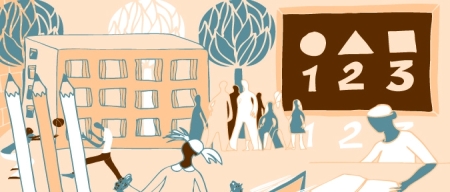Brussels, 12 June 2008: On the occasion of the World Day Against Child Labour, the ITUC is launching a new “Mini Action Guide on Child Labour,” providing campaigning tools and direct support to trade unions to fight against child labour. According to the ILO, some 218 million children between the ages of 5 and 14 are involved in child labour. Many of these children work long hours, often in dangerous conditions.
The guide, which was produced with support from the ILO-IPEC programme, highlights the fact that some sixty-nine percent of working children are involved in agriculture compared with nine percent in industry. The Asia-Pacific region accounts for the largest number of child labourers with 122 million, followed by sub-Saharan Africa (49.3 million) and Latin America and the Caribbean (5.7 million). With twenty-six percent, the proportion of children engaged in economic activities in sub-Saharan Africa is currently the highest of any region in the world. Child labour can also be found in many industrialised countries.
According to the ITUC mini guide of action, trade unions have a responsibility to society and workers in general to ensure that labour standards and legislation are respected by all employers at all levels. Workers’ organisations have a long tradition of defending human rights and workers’ rights, and child labour violates both children’s and adults’ rights.
The World Day Against Child Labour this year is emphasizing education as a key factor in the eradication of child labour. The day will be marked around the world with activities to raise awareness that education is the right response to child labour. Around 72 million children of primary school age are not enrolled in school. There are also many who are enrolled but who do not attend regularly or who drop out. Good quality education and training is necessary for children if they are to acquire the skills necessary to succeed in the labour market; such education and training is also important to economically and socially excluded children and youth so that they can lift themselves out of poverty. Wherever children miss out on education, poverty will continue from one generation to the next, explains the mini guide.
“Too many children have lives profoundly affected by the fact that instead of going to school they have to go to work,” said Guy Ryder, ITUC general secretary. “Effort must be made by all, with governments, employers, unions and others all playing their part,“ he added.
To fight against child labour, the guide gives advice on issues such as using collective bargaining, participation in tripartite dialogue, promoting international labour standards, joining the Global March Against Child Labour and the Global Trade Union Alliance to Combat Forced Labour and Trafficking, and campaigning for the ratification and implementation of the ILO Conventions No. 138 and No.182.
The ITUC is closely linking its work in the Global March Against Child Labour and the newly-emerging Global Trade Union Alliance to Combat Forced Labour and Trafficking. The ILO estimates that up to fifty percent of all forced labour victims worldwide are children. Increasingly, children are becoming forced child labourers as a result of human trafficking. Children in in-house domestic work, in rural agriculture or isolated estates, in mining, brick making, textiles and fisheries are particularly vulnerable to this “worst form of child labour” as specified in ILO Convention 182.
On this World Day Against Child Labour, the ITUC shares the serious concerns with the ILO about the increased risk that the reconstruction of Burma will involve further use of child labour, forced labour, human trafficking, and military recruitment of children. Despite the fact that Burma officially made human trafficking illegal in September 2005, trafficking is still a serious problem in the country. A particular concern is the possibility that displaced and orphaned children will be pushed into forced labour, as traffickers will target displaced people and women and children who have lost their families. Unaccompanied or separated children are easily deceived by promises of safety and a better place to live, and “brokers” are reportedly recruiting children in shelters already.
For more information on IPEC (International Program on the Elimination of Child Labour), please click here
Read the full ITUC mini action guide
Information on 12 to 12:
What is 12 to 12? The 12 to12 Community Portal is a community of people from various walks of life all working together against child labour. The aim of this initiative is to bring attention to the issue of child labour from June 12th to June 12th, and every day after that until child labourers are finally given the chance to enjoy their rights as children and one day realize their full potential as the adults that they will become. Fore more information on 12 to 12: www.12to12.org
The ITUC represents 168 million workers in 155 countries and territories and has 311 national affiliates.
For more information, please contact the ITUC Press Department on +32 2 224 0204 or +32 476 621 018.


